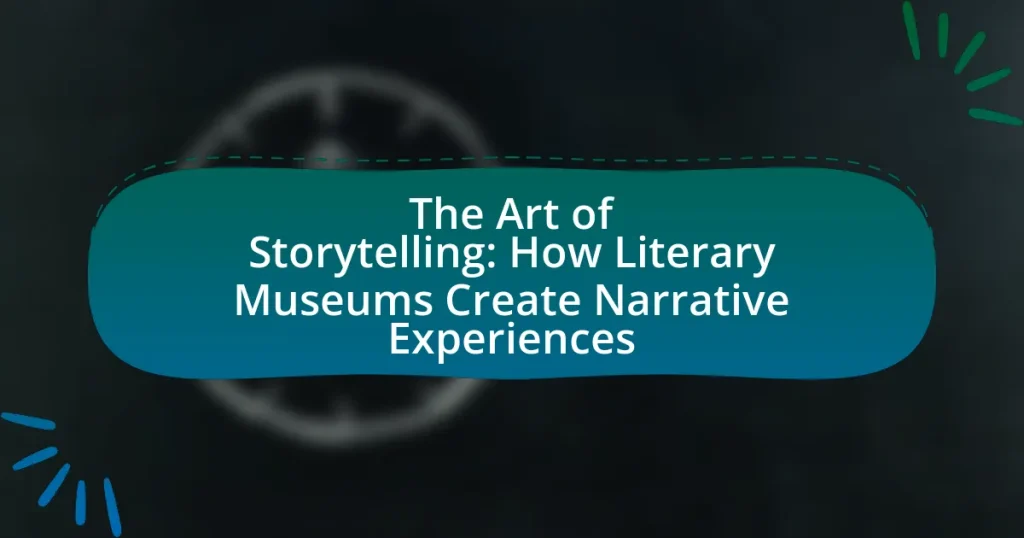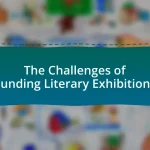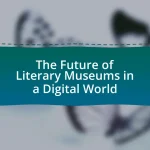The article focuses on the art of storytelling within literary museums, highlighting how narrative techniques are employed to engage visitors with the lives and works of authors. It discusses the various methods used, such as immersive exhibits, interactive displays, and multimedia presentations, which enhance visitor understanding and emotional connection to literary history. Key elements of effective storytelling, including narrative structure, character development, and sensory engagement, are examined, along with the importance of storytelling in preserving literary heritage and enhancing educational experiences. The article also addresses the challenges and opportunities faced by literary museums in implementing storytelling strategies, emphasizing the role of technology and community engagement in creating dynamic narrative experiences.
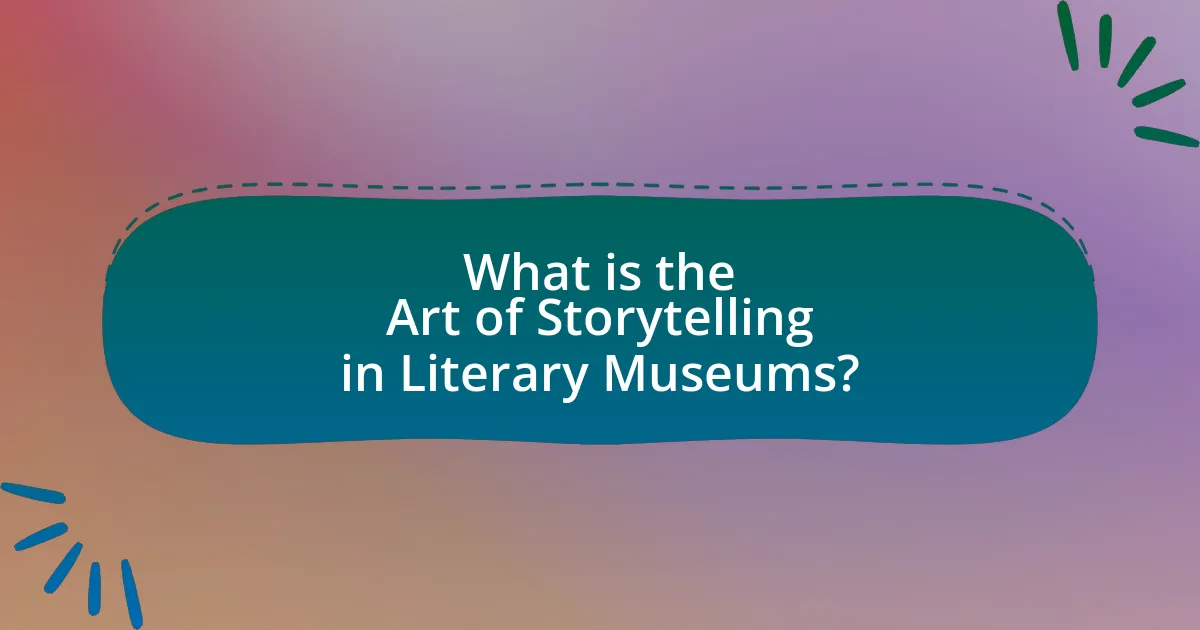
What is the Art of Storytelling in Literary Museums?
The art of storytelling in literary museums involves the use of narrative techniques to engage visitors with the lives and works of authors. Literary museums employ various methods such as immersive exhibits, interactive displays, and curated artifacts to create a compelling narrative experience that connects audiences to literary history. For instance, the use of personal letters, manuscripts, and multimedia presentations allows visitors to explore the context of an author’s work, enhancing their understanding and appreciation. This approach not only preserves literary heritage but also fosters a deeper emotional connection between the audience and the stories being told.
How do literary museums utilize storytelling techniques?
Literary museums utilize storytelling techniques by curating immersive experiences that engage visitors through narrative-driven exhibits. These museums often employ multimedia presentations, interactive displays, and guided tours that weave together the lives and works of authors, creating a cohesive narrative that enhances understanding and appreciation of literature. For instance, the Charles Dickens Museum in London uses artifacts, letters, and personal items to tell the story of Dickens’ life and the societal context of his works, allowing visitors to connect emotionally with the narrative. This approach not only educates but also fosters a deeper connection to the literary figures and their contributions to culture.
What are the key elements of storytelling in this context?
The key elements of storytelling in the context of literary museums include narrative structure, character development, thematic depth, and sensory engagement. Narrative structure provides a framework that guides the audience through the story, often utilizing a beginning, middle, and end to create a cohesive experience. Character development allows visitors to connect emotionally with the figures represented, enhancing their investment in the narrative. Thematic depth introduces underlying messages or moral questions, prompting reflection and discussion among visitors. Sensory engagement involves the use of visual, auditory, and tactile elements to immerse the audience in the story, making the experience more memorable and impactful. These elements work together to create a rich narrative experience that resonates with visitors, as evidenced by successful exhibitions in literary museums that effectively utilize these storytelling techniques.
How do these elements enhance visitor engagement?
Elements such as immersive storytelling, interactive exhibits, and curated narratives enhance visitor engagement by creating a deeper emotional connection to the content. Immersive storytelling allows visitors to experience narratives in a multi-sensory way, making the stories more relatable and memorable. Interactive exhibits encourage participation, fostering a sense of ownership and investment in the experience. Curated narratives guide visitors through a cohesive journey, ensuring that the information is not only informative but also engaging. Research indicates that museums employing these strategies see increased visitor satisfaction and retention, as evidenced by a study from the American Alliance of Museums, which found that interactive experiences can boost visitor engagement by up to 40%.
Why is storytelling important in literary museums?
Storytelling is important in literary museums because it enhances visitor engagement and fosters a deeper understanding of literary works and their contexts. By weaving narratives around authors, their creations, and historical backgrounds, literary museums create immersive experiences that resonate emotionally with visitors. For instance, storytelling can transform a simple exhibit into a compelling journey through an author’s life, illustrating how personal experiences influenced their writing. This approach not only captivates audiences but also aids in the retention of information, as studies show that narratives are more memorable than isolated facts. Thus, storytelling serves as a vital tool in literary museums to connect visitors with literature on a profound level.
What role does storytelling play in preserving literary heritage?
Storytelling plays a crucial role in preserving literary heritage by transmitting cultural narratives, values, and historical contexts across generations. Through oral traditions and written texts, storytelling captures the essence of a society’s experiences, beliefs, and artistic expressions, ensuring that these elements remain accessible to future audiences. For instance, literary museums often utilize storytelling techniques to engage visitors with the works of authors, thereby fostering a deeper understanding of the cultural significance behind those texts. This method not only honors the original creators but also contextualizes their contributions within the broader tapestry of literary history, reinforcing the importance of preserving such heritage for educational and cultural continuity.
How does storytelling contribute to educational experiences?
Storytelling enhances educational experiences by fostering engagement and facilitating deeper understanding of complex concepts. When narratives are used in education, they create emotional connections that make information more relatable and memorable. Research indicates that stories activate multiple areas of the brain, including those responsible for language, sensory experiences, and emotions, which can lead to improved retention of information. For instance, a study published in the journal “Educational Psychology” by Green and Brock (2000) found that individuals who engaged with stories demonstrated better comprehension and recall compared to those who received information in a non-narrative format. This evidence supports the idea that storytelling is a powerful tool in education, as it not only captures attention but also enhances cognitive processing and learning outcomes.
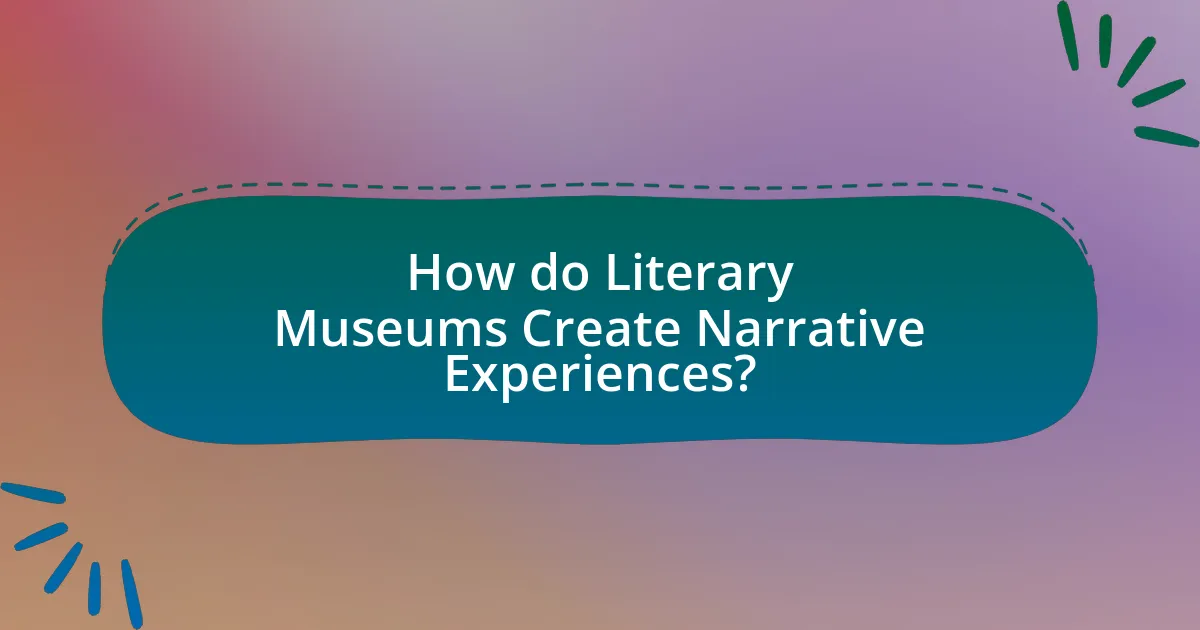
How do Literary Museums Create Narrative Experiences?
Literary museums create narrative experiences by curating immersive environments that engage visitors with the stories and contexts of literary works. These museums utilize artifacts, manuscripts, and multimedia presentations to provide a tangible connection to authors and their narratives, allowing visitors to explore the themes and historical backgrounds of the literature. For instance, the Ernest Hemingway Home and Museum in Key West showcases Hemingway’s personal belongings and writing spaces, which enhances the understanding of his literary contributions and personal experiences. This approach not only educates visitors about the authors but also invites them to experience the narratives in a more profound and personal way, fostering a deeper appreciation for literature.
What methods do literary museums use to tell stories?
Literary museums use various methods to tell stories, including interactive exhibits, guided tours, multimedia presentations, and immersive environments. Interactive exhibits engage visitors by allowing them to participate in the storytelling process, often through hands-on activities or digital interfaces. Guided tours provide curated narratives delivered by knowledgeable staff, enhancing the visitor’s understanding of the literary works and their contexts. Multimedia presentations, such as videos and audio recordings, enrich the storytelling experience by incorporating different media formats that appeal to diverse audiences. Immersive environments recreate settings from literary works, allowing visitors to experience the narrative in a tangible way, which can deepen emotional connections to the stories being told. These methods collectively enhance the storytelling experience, making literature accessible and engaging for a wide range of audiences.
How do exhibits and displays facilitate storytelling?
Exhibits and displays facilitate storytelling by providing a visual and interactive context that enhances narrative engagement. They utilize artifacts, images, and multimedia elements to create immersive environments that allow visitors to experience stories in a tangible way. For instance, literary museums often showcase original manuscripts, personal letters, and photographs that connect visitors to the lives and works of authors, thereby deepening their understanding of the narrative. Research indicates that interactive displays can increase visitor retention of information by up to 50%, demonstrating the effectiveness of these methods in storytelling.
What role does technology play in enhancing narrative experiences?
Technology significantly enhances narrative experiences by providing interactive and immersive elements that engage audiences more deeply. For instance, virtual reality (VR) and augmented reality (AR) allow users to experience stories in a three-dimensional space, making them feel as though they are part of the narrative. According to a study by the University of Southern California, immersive storytelling through VR can increase emotional engagement by up to 30%, demonstrating that technology not only enriches the narrative but also strengthens the emotional connection between the audience and the story. Additionally, digital platforms enable the integration of multimedia elements such as audio, video, and animations, which can complement traditional storytelling methods and create a more dynamic experience.
How do literary museums engage diverse audiences through storytelling?
Literary museums engage diverse audiences through storytelling by utilizing interactive exhibits, multimedia presentations, and community-focused programs that reflect various cultural narratives. These museums often curate collections that highlight the works of authors from different backgrounds, ensuring representation and relatability for a wide range of visitors. For instance, the American Writers Museum in Chicago features exhibits that celebrate diverse literary voices, allowing visitors to connect with stories that resonate with their own experiences. Additionally, storytelling events, workshops, and educational programs are designed to invite participation from local communities, fostering an inclusive environment where multiple perspectives are shared and valued. This approach not only enhances visitor engagement but also promotes a deeper understanding of the cultural significance of literature across different demographics.
What strategies are employed to attract different demographics?
Literary museums employ various strategies to attract different demographics, including targeted programming, diverse exhibitions, and community engagement initiatives. For instance, they often curate exhibitions that reflect the cultural backgrounds and interests of specific demographic groups, such as showcasing works by local authors or themes relevant to particular communities. Additionally, museums may offer educational programs tailored to different age groups, such as storytelling workshops for children or literary discussions for adults, thereby appealing to families and lifelong learners alike. Research indicates that inclusive programming can increase visitor diversity; a study by the American Alliance of Museums found that museums with community-focused initiatives saw a 30% increase in attendance from underrepresented groups.
How do interactive elements enhance audience participation?
Interactive elements enhance audience participation by actively engaging visitors in the storytelling process, making them co-creators of the narrative experience. These elements, such as touchscreens, immersive displays, and participatory exhibits, encourage visitors to interact with the content, fostering a deeper emotional connection and personal investment in the stories being told. Research indicates that interactive experiences can increase retention of information by up to 75%, compared to passive observation, as they stimulate multiple senses and promote active learning. This engagement not only enhances enjoyment but also encourages social interaction among visitors, further enriching the overall experience in literary museums.
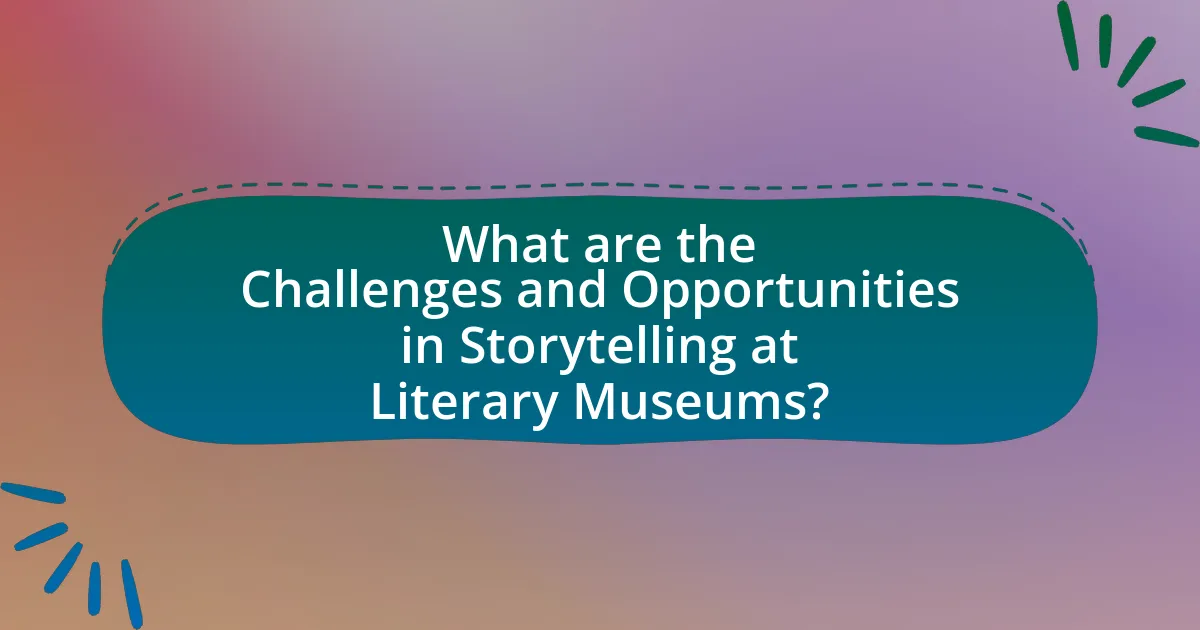
What are the Challenges and Opportunities in Storytelling at Literary Museums?
Literary museums face challenges such as limited funding, which restricts the ability to create engaging exhibits, and the difficulty of appealing to diverse audiences with varying interests in literature. Additionally, the preservation of literary artifacts can complicate storytelling efforts, as curators must balance authenticity with accessibility. Opportunities include the potential for digital storytelling, which can enhance visitor engagement through interactive experiences, and collaborations with authors and educators to create dynamic programming that attracts a wider audience. The rise of social media also offers literary museums a platform to reach new demographics and share their narratives more broadly.
What challenges do literary museums face in storytelling?
Literary museums face several challenges in storytelling, primarily the need to balance historical accuracy with engaging narratives. Museums must present factual information about authors and their works while also creating immersive experiences that captivate visitors. This challenge is compounded by the diverse audience expectations, as different visitors may seek varying levels of depth and interactivity in their experiences. Additionally, limited resources can restrict the ability to develop innovative storytelling methods, such as multimedia exhibits or interactive displays. According to a study by the American Alliance of Museums, 70% of museums report budget constraints as a significant barrier to enhancing visitor engagement through storytelling.
How can museums overcome these storytelling challenges?
Museums can overcome storytelling challenges by integrating interactive technologies and community engagement into their exhibits. By utilizing augmented reality and virtual reality, museums can create immersive experiences that allow visitors to engage with narratives in a dynamic way. For instance, the Smithsonian Institution has successfully implemented augmented reality in its exhibits, enhancing visitor interaction and understanding of complex stories. Additionally, involving local communities in the storytelling process can provide diverse perspectives and enrich the narratives presented. Research shows that community-driven projects increase visitor satisfaction and foster a deeper connection to the content, as seen in the success of the Museum of Contemporary Art in Chicago, which collaborates with local artists to tell relevant stories.
What are the implications of digital storytelling for literary museums?
Digital storytelling significantly enhances the engagement and educational potential of literary museums. By integrating multimedia elements such as videos, interactive exhibits, and social media, literary museums can create immersive experiences that attract diverse audiences. For instance, the use of augmented reality in exhibitions allows visitors to interact with literary works in innovative ways, fostering a deeper understanding of the narratives and their contexts. Research indicates that museums employing digital storytelling techniques see increased visitor satisfaction and retention, as evidenced by a study conducted by the American Alliance of Museums, which found that 70% of visitors preferred interactive experiences over traditional displays. This shift not only modernizes the presentation of literary heritage but also expands the reach of museums to younger, tech-savvy demographics, ultimately ensuring the preservation and relevance of literary culture in a digital age.
What opportunities exist for enhancing storytelling in literary museums?
Literary museums can enhance storytelling through interactive exhibits, digital technology, and community engagement. Interactive exhibits allow visitors to immerse themselves in narratives, fostering a deeper connection with the material. For example, the British Library employs touchscreens and augmented reality to bring literary works to life, enhancing visitor engagement. Digital technology, such as virtual reality experiences, can transport visitors into the settings of famous literary works, creating a more vivid storytelling experience. Additionally, community engagement initiatives, like author talks and workshops, can invite local voices into the narrative, enriching the museum’s storytelling by incorporating diverse perspectives. These strategies collectively create a more dynamic and inclusive storytelling environment in literary museums.
How can collaborations with authors and artists enrich narratives?
Collaborations with authors and artists can enrich narratives by integrating diverse perspectives and creative techniques, enhancing the depth and engagement of storytelling. For instance, when authors work with visual artists, the combination of text and imagery can create a multi-sensory experience that captivates audiences, as seen in illustrated novels and graphic storytelling. This synergy allows for the exploration of themes and emotions in a more nuanced manner, making narratives more relatable and impactful. Research indicates that cross-disciplinary collaborations can lead to innovative storytelling methods, fostering a richer cultural dialogue and expanding the audience’s understanding of the narrative.
What innovative practices can be adopted to improve visitor experiences?
Innovative practices that can be adopted to improve visitor experiences in literary museums include the integration of augmented reality (AR) and virtual reality (VR) technologies. These technologies allow visitors to engage with narratives in immersive ways, enhancing their understanding and emotional connection to the stories being told. For instance, a study by the University of Southern California found that AR experiences can increase visitor engagement by up to 30%, as they provide interactive elements that traditional exhibits lack. Additionally, personalized storytelling through mobile applications can tailor experiences based on visitor preferences, further enriching their visit. Implementing these practices not only modernizes the museum experience but also aligns with current technological trends, making literary museums more appealing to diverse audiences.
What are best practices for effective storytelling in literary museums?
Best practices for effective storytelling in literary museums include creating immersive experiences, utilizing diverse media, and engaging visitors emotionally. Immersive experiences can be achieved through interactive exhibits that allow visitors to step into the narrative, such as recreating significant settings from literary works. Utilizing diverse media, including audio, visual displays, and digital storytelling, enhances engagement and caters to different learning styles. Engaging visitors emotionally involves connecting narratives to universal themes, allowing visitors to relate personally to the stories being told. Research indicates that emotional engagement significantly enhances memory retention and visitor satisfaction, making these practices essential for impactful storytelling in literary museums.
How can museums measure the impact of their storytelling efforts?
Museums can measure the impact of their storytelling efforts through visitor surveys, engagement metrics, and qualitative feedback. Visitor surveys can quantify audience reactions and understanding of narratives, while engagement metrics, such as time spent at exhibits and social media interactions, provide insights into how stories resonate with visitors. Qualitative feedback, gathered through interviews or focus groups, offers deeper insights into emotional responses and personal connections to the stories presented. For example, a study by the American Alliance of Museums found that 70% of visitors reported a stronger emotional connection to exhibits that utilized storytelling techniques, demonstrating the effectiveness of these methods in enhancing visitor experience.
What tips can enhance the storytelling approach in literary museums?
To enhance the storytelling approach in literary museums, curators should integrate immersive experiences that engage visitors emotionally and intellectually. Utilizing interactive exhibits allows visitors to participate in the narrative, fostering a deeper connection to the literary works. For instance, incorporating augmented reality can bring stories to life, enabling visitors to visualize scenes and characters in a dynamic way. Additionally, employing diverse narrative techniques, such as oral storytelling sessions or dramatized readings, can create a multi-sensory experience that captivates audiences. Research indicates that interactive and immersive storytelling significantly increases visitor retention and satisfaction, as evidenced by studies conducted by the American Alliance of Museums, which highlight the effectiveness of engagement in educational settings.
